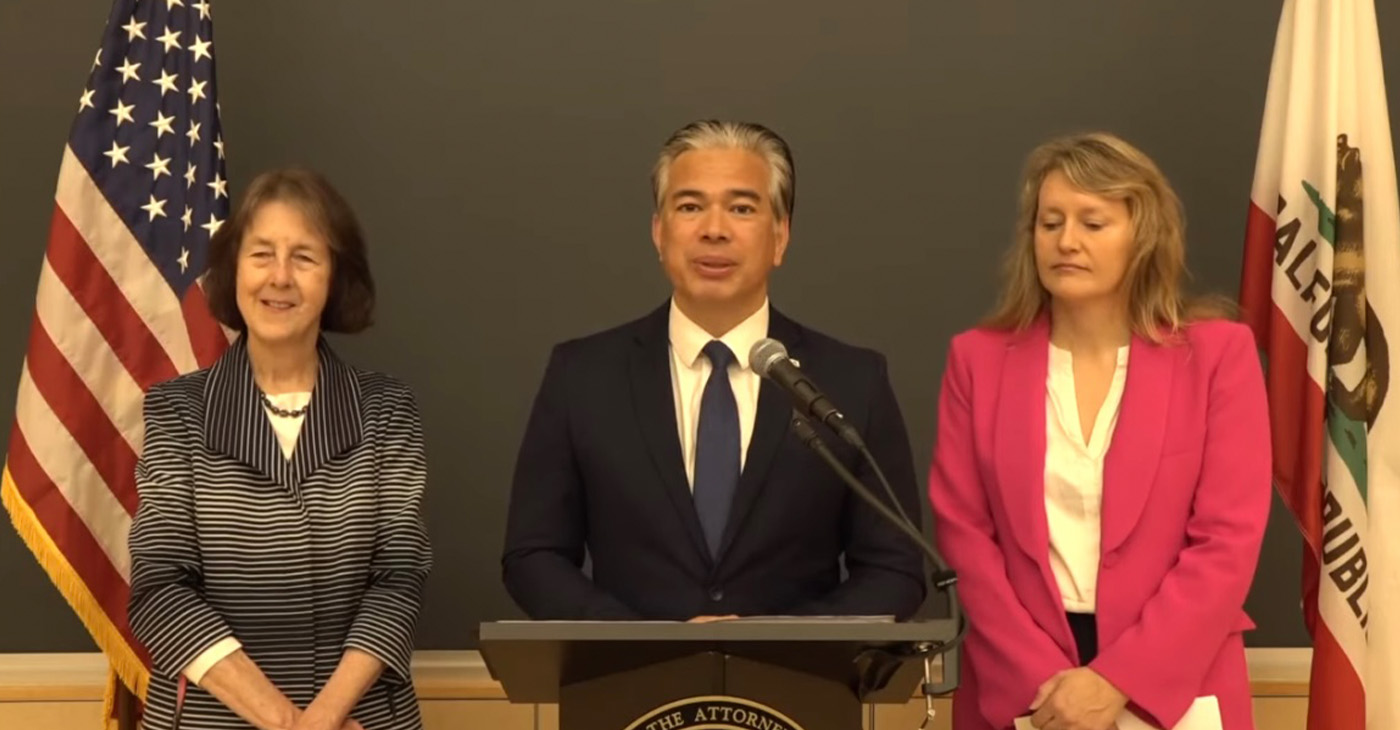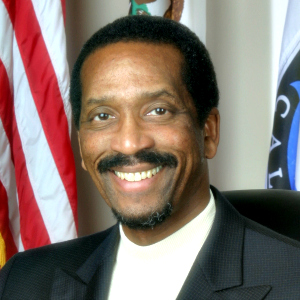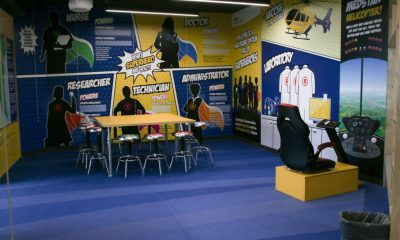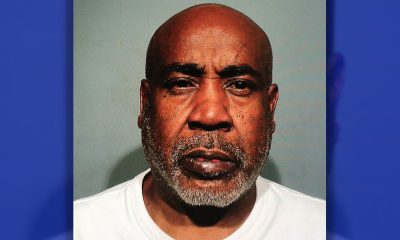Technology
Baltimore Police Often Surveil Cellphones Amid US Secrecy

This undated handout photo provided by the U.S. Patent and Trademark Office shows the StingRay II, manufactured by Harris Corporation, of Melbourne, Fla., a cellular site simulator used for surveillance purposes. A police officer testified Wednesday, April 8, 2015, that the Baltimore Police Department has used Hailstorm, a upgraded version of the StringRay surveillance device, 4,300 times and believes it is under orders by the U.S. government to withhold evidence from criminal trials and ignore subpoenas in cases where the device is used. (AP Photo/U.S. Patent and Trademark Office)
JACK GILLUM, Associated Press
JULIET LINDERMAN, Associated Press
BALTIMORE (AP) — The Baltimore Police Department has an agreement with the U.S. government to withhold certain information about secretive cellphone surveillance technology from the public and even the courts, according to a confidential agreement obtained by The Associated Press. On Wednesday, the department disclosed it has used the technology thousands of times since 2007.
The agreement between the police department and the Federal Bureau of Investigation also encourages the authorities and local prosecutors to sometimes dismiss cases instead of divulging details about the equipment. That arrangement, which was agreed to several years ago, has led police to believe that they can withhold evidence in criminal trials or ignore subpoenas in cases in which the devices are used.
The technology, using devices called Hailstorm or Stingray, can sweep up basic cellphone data from a neighborhood by tricking phones in the area that it’s a cell tower and identifying unique subscriber numbers. That data is then transmitted to the police, allowing them to locate a phone without the user even making a call or sending a text message.
The Baltimore police entered into an agreement with the Justice Department in 2011, which calls for the department to withhold information about the device in “press releases, court documents, during judicial hearings or during other public forums and proceedings.” The agreement states that the department must seek FBI approval before sharing any details with other law enforcement agencies.
The agreement also makes clear that neither the police department nor prosecutors are permitted to divulge information about the surveillance technology in court, and warns that if either agency suspects that a prosecutor is planning to provide information about the device in open court, it must “notify the FBI in order to allow sufficient time for the FBI to intervene to protect the equipment/technology and information from disclosure and potential compromise.”
The FBI’s agreement also says the agency can request the Baltimore police, in conjunction with local prosecutors, to seek dismissal of a case rather than “allowing others to use or provide” information about Harris Corp.’s surveillance technology if it would “potentially or actually” compromise the equipment.
In practice, Baltimore police officers are interpreting the nondisclosure agreement as instructing them to withhold evidence from the court, and ignore subpoenas relating to the technology.
Emmanuel Cabreja, a detective with the department’s advanced technical team, testified Wednesday in a carjacking and robbery case. In that case, Cabreja’s team used a Hailstorm to locate a stolen cellphone inside a group home where defendant Nicholas West was living. A juvenile was also charged in the case.
He said the department has deployed Hailstorm and similar technology roughly 4,300 times since 2007. Personally, Cabreja said he’d used it between 600-800 times in the past two years.
“Does (the document) instruct you to withhold evidence from the state’s attorney and the circuit court of Baltimore city, even if upon order to produce?” defense attorney Joshua Insley asked Cabreja.
“Yes,” he said. Cabreja also said he ignored a subpoena he received Tuesday to bring the device with him to court.
Police across the country have largely been kept silent on how they use the devices. Because documents about Stingrays and Hailstorms are regularly censored in public records requests by citizens and journalists, it’s not entirely clear what information the devices could capture — such as the contents of phone conversations and text messages, what they routinely capture based on how they’re configured, or how often they might be used.
Cabreja on Wednesday said the Hailstorm can identify phones from a 360-degree antenna from about a city block away in distance. He said no data, or content, is captured in the process; however he said the device detects the unique identification numbers assigned to cellphones that have the same service provider as the targeted phone within that radius.
“Given what (Cabreja) said about the technology involved, and the way a Hailstorm device connects to and ‘registers’ non-targeted cellphones, it’s likely that thousands of people in Baltimore have been unknowingly impacted by police cellphone surveillance,” defense attorney James Johnston told The Associated Press. Johnston represented the juvenile defendant in Wednesday’s case.
The FBI declined to answer questions about the case late Wednesday.
This is not the first case to inspire a push-pull between prosecutors, defense attorneys and judges about revealing details of the Baltimore Police Department’s use of the clandestine technology.
Baltimore Circuit Judge Barry Williams presided over an earlier trial in which the police apparently used a surveillance device to collect evidence on a robbery suspect. At a November 2014 hearing, Williams lost his patience with a state prosecutor after a police technician wouldn’t answer defense attorney’s questions about the device — citing the FBI nondisclosure agreement.
“You don’t have a nondisclosure agreement with the court,” Williams told police Det. John Haley, part of the department’s advanced technical team. “Answer the question.”
The prosecutors instead withdrew the evidence, avoiding the contempt citation and questions about the equipment’s use.
Two months earlier, Williams threw out evidence in yet another criminal case involving cellphone tracking after a police sergeant said there were unspecified “homeland security” issues when asked why the suspect was stopped.
“If it goes into homeland security issues, then the phone doesn’t come in,” Williams said, telling the prosecutor: “You can’t just stop someone and not give me a reason.”
This week, officials in upstate New York released documents about their Stingray use after a state judge ordered them to do so.
___
Associated Press writer Eric Tucker in Washington contributed to this report.
___
View the nondisclosure agreement: http://apne.ws/1NWnRXs
Follow on Twitter: Jack Gillum at https://twitter.com/jackgillum and Juliet Linderman at https://twitter.com/julietlinderman
Copyright 2015 The Associated Press. All rights reserved. This material may not be published, broadcast, rewritten or redistributed.
Community
Attorney General Rob Bonta, Oakland Lawmakers, Introduce Legislation to Protect Youth Online
At a press conference in downtown Oakland on Jan. 29, Attorney General Rob Bonta joined Sen. Nancy Skinner (D-Berkeley) and Assemblymember Buffy Wicks (D-Oakland) to announce two pieces of legislation designed to protect children online. The bills are Senate Bill (SB) 976, the Protecting Youth from Social Media Addiction Act and Assembly Bill (AB) 1949, the California Children’s Data Privacy Act.

By Magaly Muñoz
At a press conference in downtown Oakland on Jan. 29, Attorney General Rob Bonta joined Sen. Nancy Skinner (D-Berkeley) and Assemblymember Buffy Wicks (D-Oakland) to announce two pieces of legislation designed to protect children online.
The bills are Senate Bill (SB) 976, the Protecting Youth from Social Media Addiction Act and Assembly Bill (AB) 1949, the California Children’s Data Privacy Act.
Skinner authored SB 976, which addresses online addiction affecting teenage users, while Wicks’s bill, AB 1949, takes on big tech by proposing data privacy and children rights protections.
“Social media companies unfortunately show us time and time again that they are all too willing to ignore the detriment to our children, the pain to our children, the mental health and physical challenges they face, in order to pursue profits,” Bonta said.
SB 976 would allow parents to control the nature and frequency of the content their under-18-year-old children see on social media. Notifications from social media platforms would also be paused from midnight to 6 am and controls would allow parents to set time limits on their children’s usage based on their discretion.
Skinner stated that the longer that kids are on their phones during the day, the higher the risk for depression, anxiety and other related issues.
The bill would also push to get rid of addictive media that is harmful for young women and girls, specifically image filters that mimic cosmetic plastic surgery.
Bonta and 33 other attorney generals had previously filed a lawsuit against Meta, owner of the popular social media applications Instagram and Facebook. The filing claims that the company purposefully uses algorithmized content that harms younger audiences.
“Social media companies have the ability to protect our kids, they could act, but they do not,” Skinner said.
The Child Data Privacy Act would strengthen existing protections for data privacy under the California Consumer Privacy Act (CCPA). The lawmakers argue that the law does not have effective protection for those under 18 years old.
Wicks stated that the bill would forbid businesses from collecting, using, sharing, or selling personal data of anyone underage unless they receive informed consent, or it becomes necessary for the purpose of the business.
Wicks added that the acts would make it so that a search on the internet like “How do I lose weight?” would not result in dieting pill advertisements targeting youth, which, some experts report, could be harmful to their mental and physical health.
“In a digital age where the vulnerabilities of young users are continually exploited, we cannot afford to let our laws lag behind, our children deserve complete assurance that their online experience will be safeguarded from invasive practices,” Wicks said.
Supporters of the two acts say they have gained bipartisan support issue, but the authors and Bonta expect them to be met with pushback from the affected companies.
#NNPA BlackPress
Unleashing the Power_ Discover the The Thrills…F-TYPE Convertible
Performance & Handling Powered by a robust 5.0 Liter Supercharged 8 Cylinder Gas Engine, the F-Type R75 doesn’t just purr; it roars with a mighty 575 horsepower and 516 lb-ft of torque. Coupled with an 8-speed Automatic Transmission, the car offers an exhilarating drive that is both fast and smooth. The All-Wheel Drive system ensures […]
The post Unleashing the Power_ Discover the The Thrills…F-TYPE Convertible first appeared on BlackPressUSA.

Performance & Handling
Powered by a robust 5.0 Liter Supercharged 8 Cylinder Gas Engine, the F-Type R75 doesn’t just purr; it roars with a mighty 575 horsepower and 516 lb-ft of torque. Coupled with an 8-speed Automatic Transmission, the car offers an exhilarating drive that is both fast and smooth. The All-Wheel Drive system ensures excellent traction and stability, making it a joy to handle in various driving conditions. The Electric Power Assisted Steering and JaguarDrive Control with Selectable Driving Modes add to the car’s agility, providing a driving experience that is as intuitive as it is thrilling. Additionally, the Adaptive Dynamics and Electronic Active Differential with Torque Vectoring by Braking enhance the car’s responsiveness, making every turn a testament to its engineering prowess. Unique to AutoNetwork.com.
with Selectable Driving Modes add to the car’s agility, providing a driving experience that is as intuitive as it is thrilling. Additionally, the Adaptive Dynamics and Electronic Active Differential with Torque Vectoring by Braking enhance the car’s responsiveness, making every turn a testament to its engineering prowess. Unique to AutoNetwork.com.
Like us on and share https://www.facebook.com/autonetwork
#AutoNetwork
#AutoNetworkReports
Subscribe to our channel now for more videos.
Twitter http://www.twitter.com/liveautos
LinkedIn http://www.linkedin.com/in/autonetwork
Coupons Offers and Deals https://www.couponsoffersanddeals.com/
The post Unleashing the Power_ Discover the The Thrills…F-TYPE Convertible first appeared on BlackPressUSA.
#NNPA BlackPress
Elevate Your Ride…
Join us for a virtual car’s best-detailed walkaround of the sleek and stylish 2024 Jaguar F-TYPE AWD convertible. Get an up-close look at the exterior design, interior features, and performance capabilities of this luxury sports car. From its powerful engine to its advanced technology, this video will give you a comprehensive overview of what makes […]
The post Elevate Your Ride… first appeared on BlackPressUSA.

Join us for a virtual car’s best-detailed walkaround of the sleek and stylish 2024 Jaguar F-TYPE AWD convertible. Get an up-close look at the exterior design, interior features, and performance capabilities of this luxury sports car. From its powerful engine to its advanced technology, this video will give you a comprehensive overview of what makes the F-TYPE AWD convertible stand out on the road. Unique to AutoNetwork.com.
Like us on and share https://www.facebook.com/autonetwork
#AutoNetwork
#AutoNetworkReports
Subscribe to our channel now for more videos.
Twitter http://www.twitter.com/liveautos
LinkedIn http://www.linkedin.com/in/autonetwork
Coupons Offers and Deals https://www.couponsoffersanddeals.com/
The post Elevate Your Ride… first appeared on BlackPressUSA.
-

 Activism4 weeks ago
Activism4 weeks agoOakland Post: Week of March 27 – April 2, 2024
-

 #NNPA BlackPress4 weeks ago
#NNPA BlackPress4 weeks agoFrom Raids to Revelations: The Dark Turn in Sean ‘Diddy’ Combs’ Saga
-

 #NNPA BlackPress4 weeks ago
#NNPA BlackPress4 weeks agoCOMMENTARY: D.C. Crime Bill Fails to Address Root Causes of Violence and Incarceration
-

 #NNPA BlackPress4 weeks ago
#NNPA BlackPress4 weeks agoCOMMENTARY: Lady Day and The Lights!
-

 #NNPA BlackPress4 weeks ago
#NNPA BlackPress4 weeks agoMayor, City Council President React to May 31 Closing of Birmingham-Southern College
-

 #NNPA BlackPress4 weeks ago
#NNPA BlackPress4 weeks agoBaltimore Key Bridge Catastrophe: A City’s Heartbreak and a Nation’s Alarm
-

 #NNPA BlackPress4 weeks ago
#NNPA BlackPress4 weeks agoBaltimore’s Key Bridge Struck by Ship, Collapses into Water
-

 #NNPA BlackPress4 weeks ago
#NNPA BlackPress4 weeks agoBeloved Actor and Activist Louis Cameron Gossett Jr. Dies at 87



















































